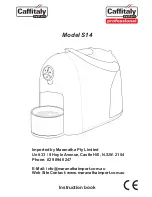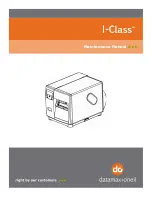
Page 2
Icemaker Information
6-2
#7005333 - Revision C - September, 2010
Built-In (BI) Series
Built-In (BI) Series
ICEMAKER SYSTEM INFORMATION
Built-In Series units utilizes a Japan-Servo ® icemaker.
Its operation is not complex, but understanding its com-
ponents and operation cycle will assist a Service
Technician in make proper diagnosis of problems.
TO AVOID ELECTRIC SHOCK, ALWAYS DISCON-
NECT ELECTRICAL POWER TO UNIT WHEN SER-
VICING ICEMAKER.
NOTES:
• Water fill time/volume in the BI Series is controlled by
the electronic control ‘s micriprocessor. The micro-
processor observes the volumetric flow through the
water valves via a low DC voltage signal from the
flow meter, with every one revolution of the turbine
inside the flow meter equaling 0.02 oz (0.5 ml) The
electronic control instructs the valve to remain open
long enough to deliver approximately 3.5 oz (105 ml)
of water. This timeframe will vary depending on
water pressure.
• Adjsuting the water fill adjusting screw at the icemak-
er will have no effect on water fill time/volume.
• The “ICE MAKER” key on the control panel activates
the icemaker system. If the ice cube icon is not dis-
played on the LCD, the icemaker system is OFF.
• To allow ice to freeze fully and reduce effects of low
water pressure, the electronic control disables the ice-
maker system for 45 minutes after each ice harvest.
• Power to the freezer lights, is monitored to help con-
trol icemaker operation. If the freezer door is open,
power to the icemaker is interrupted.
• The icemaker system is disabled when the unit is in
Sabbath Mode.
ICEMAKER COMPONENTS
Following are descriptions that explain the function of
each icemaker component. The components are dia-
gramed in
Figure 6-1
on the next page.
Support -
The support is the housing around the elec-
trical components and wire connections. The support is
attached to the ice mold.
Mounting Plate -
The drive motor, holding switch,
water valve solenoid switch, timing gear, timing cam
and water fill adjusting screw are attached to the metal
mounting plate. The mounting plate is then attached to
the support.
Drive Motor -
AC voltage supplied to the drive motor
causes the motor to operate. The motor has a single
output shaft with a small gear. The motor gear
drives/spins the timing gear.
Timing Gear -
The timing gear is driven/spun by the
drive motor gear and is attached to the timing cam.
Timing Cam -
The timing cam is attached to the tim-
ing gear and the ice ejector is inserted into the center of
the timing cam. As the timing cam rotates, high and
low spots on the cam operate the water valve solenoid
switch and the holding switch. The timing cam also
moves the lever arm side to side and rotates the ice
ejector.
Ice Mold -
The ice mold is where the eight crescent
shaped ice cubes are formed.
Mold Heater -
The mold heater uses 165 watts to
thaw the ice free from the mold.
Ice Ejector -
The drive end of the ice ejector is “D”
shaped to fit into the “D” shaped hole in the timing cam.
It has eight blades which rotate and sweep the ice from
the mold cavities during the ejection phase of the cycle.
Ice Stripper -
The stripper is attached to the dumping
side of the mold, serving as a decorative side cover and
it also prevents ice from falling back into the mold.
Bearing / Inlet -
The bearing / inlet is attached to the
ice mold, opposite the support. Water enters the bear-
ing / inlet and is directed to the ice mold. The
bearing/inlet also supports the ice ejector at the end
opposite the timing cam.
Thermostat -
The thermostat is a single-pole, single-
throw, bi-metal switch. At 15°F (-9°C) ± 3° it closes,
starting the ice ejection phase.
Thermal-Mastic -
A substance similar in appearance
to grease that is applied between the thermostat and
the ice mold. Its purpose is to increase thermal con-
ductivity between the mold and the thermostat.
Lever Arm and Shut-off Arm -
The lever arm is
moved side to side by two revolutions of the timing
cam. As it moves, it raises and lowers the shut-off arm
and operates the shut-off switch to control the quantity
of ice production. If the shut-off arm comes to rest on
top of the ice in the storage bin during either revolution,
the shut-off switch will remain open, stopping ice pro-
duction at the end of that revolution.
Water Valve Solenoid Switch -
A single-pole, double-
throw type switch that allows electricity to the water
valve solenoid, opening the valve, during the fill cycle.
Holding Switch -
A single-pole, double-throw type
switch that assures completion of a revolution once the
icemaker has been energized.
Shut-off Switch -
A single-pole, double-throw type
switch that stops ice production when the ice bin is full.
TCO (Thermal Cut Out) -
The TCO is thermal protec-
tion device in the wire harness that would open in the
event of mechanical failure, thus protecting against over
heating. (The TCO is not shown in diagram.)




























